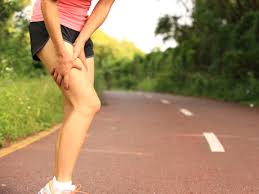Stop Hamstring Strains/Quadriceps Strains
As fitness enthusiasts can attest, injuries can be frustrating and painful. Learning to prevent and manage injuries is important for the serious, as well as the casual, athlete.
By employing injury prevention techniques outlined here you can reduce, but never totally eliminate, the risk. Thigh injuries, like hamstring sprains and quadriceps sprains, which are among the most common seen both in endurance and explosive sports, are more common as the age increases and do not spare athletes of either gender. Younger athletes are not immune.
Here are five ways to stop thigh injuries before they stop you:
Never Neglect Your Warm-Up
Of all the things you do as part of your lower body workout session, the warm-up may be the most important. It’s also what tends to get skipped over the most often.
A good warm-up enhances blood and oxygen flow to the muscle tissues in preparation for exercise. It also increases the warmth and the range of motion. When you exercise intensely with tight muscles, one wrong move and you could damage a muscle or tendon and upset your training program for weeks.
A good 5-10 minute warm-up should consist of light cardiovascular exercise and range of motion exercises. Note that this is not the time to be doing thorough stretches.
Focus On Building Strength With Compound Moves
Next, another important way to reduce injury risk includes working on compound movements. Compound movements are those that use more than one muscle group. The goal is to build strength throughout the glutes, hamstrings, and quads so that your muscles can easily handle repetitive and strenuous movements.
Attention to muscle strength of both the quads and hamstrings helps maintain the muscle balance important for normal joint function. Strive for a balanced workout regimen rather than overdevelopment of one muscle group.
Use Compression Garments Wisely
Thigh compression sleeves or compression wraps are another fantastic way to prevent injury as well as treat any injuries that occur. These compression braces are meant to be worn tight over the thigh region and will not only help keep the muscles warmer, but also provide support and control muscle fatiguing oscillations.
When getting fit for thigh compression sleeves, such as hamstring sleeves, remember that you want the fit to be tight, but still comfortable.The Body Helix compression sleeve is built to allow unrestricted movement while still providing beneficial support and compression.
Stay Limber – Don’t Skip Those Stretches
Utilizing a thorough stretching program is key in preventing thigh injuries. After your workout session is completed, follow it up with some preventative stretches.
The muscles will be tight and tense from the training just completed so stretching can help to loosen up that tightness and reduce the chances that you experience delayed onset muscle soreness (DOMS).
Additionally, stretching while the muscles are warm is a great way to help increase your flexibility, which can help prevent injury down the road. The more limber you are during any exercise you perform, the lower your injury risk will be.
Stretching is something that you must work at nearly daily in order to sustain benefit and it’s frequently overlooked.
Monitor For Overtraining
The last step to help prevent thigh injuries before they start is to monitor for signs of overtraining. When on the verge of overtraining, muscles will be fatigued making it more likely that from is compromised. Incorrect form puts abnormal stresses on muscles and joints and the risk of injury skyrockets.
Some of the classic signs of overtraining include:
- Difficulty falling or staying asleep
- Unexplained changes to your appetite and/or bodyweight
- Fatigue that lasts for hours after a workout session
- Declining exercise performance
- Irritability and moodiness
- Feelings of depression
- Recurrent illness including the common cold and other viral infections
- Reduced energy and stamina
If you experience any of these symptoms, back off on your training and then re-assess your program. You may not be taking as much time off each week in order to fully recover and come back stronger than you were.
Overtraining can lead to muscle breakdown and weakness and increase the risk of injury.
Keep these five tips in mind as you train. Implementing these efforts may not prevent all thigh injuries but it will certainly reduce the likelihood.
Learn, Share, Inspire

